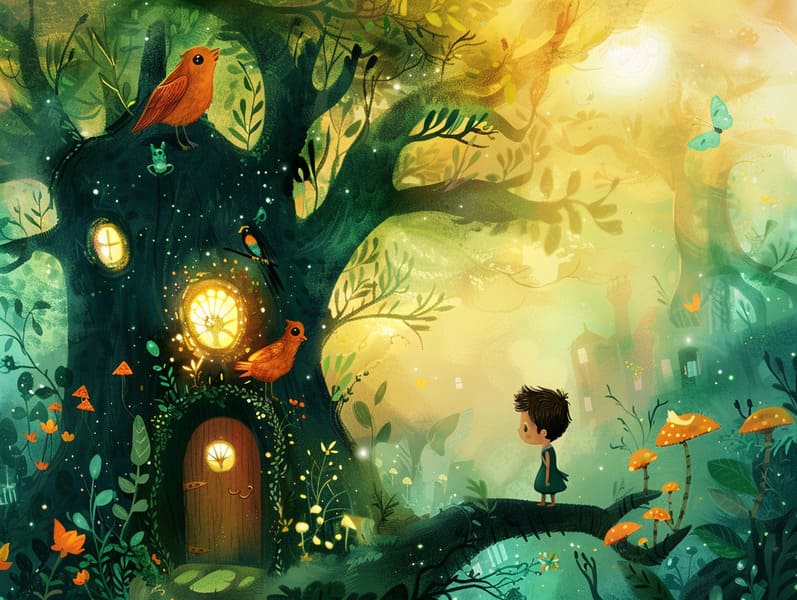Exploring the Roots of Children's Fairy Tales and Their Continued Appeal.
Exploring the Roots of Children's Fairy Tales and Their Continued Appeal.
Blog Article

Legendary fairy tales have long histories. These stories have been passed down from one generation to the next millennia before they were ever documented. They originated from a variety of traditions, including European traditions. They were initially transmitted among elders, often carrying themes and messages relevant to the societal norms and beliefs of the time.
The Grimm brothers, the two Grimm brothers, were among the first to compile many of these beloved tales. Their compilation, "Grimm's Folk Tales," included narratives like "The Little Glass Slipper," "Little Brother and Little Sister," and "Schneewittchen," which have since become essentials in the world of beloved fairy tales. Similarly, the Danish author's enchanting fairy tales, such as "The Story of the Little Mermaid," and "The Ugly Duckling," have captivated hearts worldwide, cementing their place in the pantheon of classic fairy tales.
Despite being ancient, classic fairy tales remain as relevant as ever, especially as kids' bedtime tales. These whimsical stories are now available in diverse formats, including vibrantly illustrated books, delightful animations, and web-based fairy tales.
Their enduring popularity can be connected to several whimsical characteristics:
Crucial Morals: Traditional fairy tales often whisper important moral lessons. Stories like "The Tale of the Boy Who Cried Wolf" teach the merit of honesty, while "The Tale of the Tortoise and the Hare" demonstrate the merits of resolve and unassuming nature. These stories offer the young clear distinctions between virtue and vice, guiding their moral compass in a subtle yet meaningful way.
Kindness and Comprehension: Classic fairy tales frequently depict protagonists facing challenges and problems, urging young readers to empathize with their struggles and encourage their triumphs. For instance, "Beauty and the Beast" reveals the necessity of looking past the exterior to recognize the true character of a individual, nurturing perception and perception.
Cultural Recognition: Many traditional fairy tales are imbued with the cultural contexts from which they came. Immersing in these narratives can provide intriguing perspectives into different societies, cultivating a sense of world appreciation and knowledge.
Creativity and Imagination: The mythical elements in classic fairy tales—supernatural elements—engender children’s creative thoughts. These tales transport readers to mythical realms, unleashing innovative thinking and a sense of excitement that lasts a lifetime.
Old fairy tales are not only delightful but also informative. They serve as whimsical tools in promoting various mind and heart abilities in children. When classic fairy tales are spoken, they boost verbal skills by showing get more info new vocabulary and complicated sentence structures. This practice also cultivates listening abilities and attention, as little ones remain attentive, expectant to see what happens next.
Furthermore, reflecting on the themes and characters of traditional fairy tales can advance problem-solving abilities and reasoning skills. Children are guided to spot patterns, anticipate outcomes, and figure out cause and effect. These examinations also promote the young speak out their thoughts and feelings, nurturing their emotional intelligence.
In today’s online age, the abundance of web-based fairy tales has made these fairy tales more accessible than ever. Online resources and programs feature large libraries of old fairy tales that can be explored or listened via anytime, anywhere. Fairy tales read aloud are particularly popular, featuring an fascinating method for young readers to relish these whimsical stories. Voice books and read-aloud videos transport characters and settings to life, often accompanied by captivating melodies and tunes that elevate the story journey.
The everlasting appeal of classic fairy tales lies in their ability to transform to present eras while preserving their fundamental ideas. Contemporary reimaginings of these tales often show more varied figures and modern settings, making them relevant to today’s audience. However, the basic principles of braveness, generosity, and justice remain unchanged, continuing to resonate with listeners of all ages.
Old fairy tales also offer a sense of warmth and understanding. They distribute a organized narrative with a definite beginning, middle, and end, often wrapping up with the ending of conflicts and the triumph of rightness over wrongness. This certainty can be comforting for young readers, allowing a sense of firmness in an dynamic world.
Traditional fairy tales continue to bewitch and enlighten new generations, maintaining their enchantment and significance in modern society. As bedtime stories for kids, they afford a perfect blend of magic and knowledge, enhancing moral values, empathy, and creativity. The availability of free fairy tales online and the widespread nature of fairy tales read aloud warrant that these traditional fairy tales remain acquirable to new generations.
By maintaining and circulating these narratives, we continue to cherish the rich tapestry of narrative artistry and cultural heritage. Whether you are seeing a beautifully illustrated book, enjoying a electronic collection, or hearing an narrated book, the beauty of Grimm's fairy tales is always within reach. These stories remind us of the lasting ability of fairy tales and its ability to tie us across time and space.
Even if you are perusing a vividly illustrated book, accessing a digital library, or listening via an read-aloud book, the enchantment of bedtime fairy tales is always within reach.
These fairy tales convey of the immortal essence of fairy tales and its ability to link us across generations and cultures, establishing a link that enchants and educates alike.